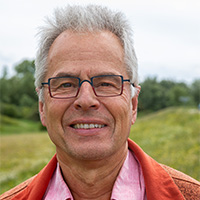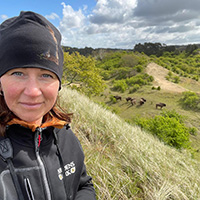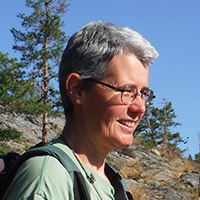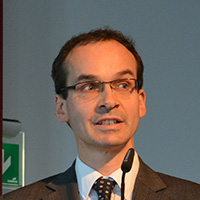In November, we’re launching a new webinar series. Join us for a series of expert-led webinars exploring practical and scientific approaches to restoring biodiversity in temperate grasslands and open ecosystems. From seed transfer techniques to flower strips and fire and grazing dynamics , leading researchers from across Europe share insights, tools, and case studies to support nature managers, policymakers, and practitioners in their work.
Grassland Restoration – Perspectives and Knowledge is a webinar series bringing together leading researchers and practitioners from across Europe to share insights into restoring biodiversity in temperate grasslands and open ecosystems.
Topics range from species-rich grassland restoration and flower strip implementation to the ecological roles of fire and grazing. Each session offers practical tools, scientific findings, and collaborative models for nature managers, conservationists, and policymakers.
Speakers include experts from Belgium, Germany, Luxembourg, the Netherlands, and Sweden, all contributing valuable perspectives from both research and fieldwork. The webinars will be recorded and published on the webpage later on.
The webinars will take place on Thursdays 4pm – 5pm.
- November 6
- November 13
- November 20
- November 27
- December 4
- December 18
More information and registration links
Date and time
November 6, 4PM-5PM
Title of speech
Restoring species-rich grasslands on dikes in the Netherlands
Speaker
Hans de Kroon is a professor of Plant Ecology at Radboud University in Nijmegen, the Netherlands. His work focusses on plant interactions and biodiversity mechanisms, particularly in grasslands. He has developed experimental facilities to study the mechanisms of root interactions belowground. Since about 10 years he is working with Dutch water boards on grasslands of levees (dikes) with the aim to enhance grassland biodiversity with new seed mixtures, soil improvement and management experiments.

Organisation
Radboud Universiteit
Country
Netherlands
Topic
This webinar wil give an overview of the grasslands on Dutch levees, their current status and potential for nature restoration, both for wild plants and bees. The main function of a dike is high water protection and therefore the dike vegetation must resist water erosion. I will show how we have tested the resistance to water erosion on dikes, an essential requirement for the large-scale restoration of species-rich dikes. Currently, we have a series of experiments in progress on developing species-rich dike vegetation, focussing on soil quality and seed mixtures. We also study the effects of drought and how species-rich dike vegation can better recover from severe drought events.
You can register up to and including October 31.
Date and time
November 13, 4PM-5PM
Title of speech
Restoring Species-Rich Grasslands: From Science to Practice
Speaker
Dr.ir. An De Schrijver is a lecturer in nature management and restoration and a researcher at the HOGENT University of Applied Sciences and Arts. In her work she consistently pursues practice-oriented solutions to real societal challenges.
Organisation
HOGent
Country
Belgium
Topic
In this session, An will explain why so few grasslands in Belgium remain biodiverse and - drawing on her applied research - share actionable tools for nature and green-space managers. She will also highlight collaboration models with farmers, who play a key role in day-to-day management and can benefit from more diverse grasslands.
Whether you manage nature reserves, public green spaces, or agricultural landscapes, you’ll gain clear guidance for achieving practical results in the field.
You can register up to and including November 7.
Date and time
November 20 4PM-5PM
Title of speech
Fire and herbivory – key drivers of temperate open ecosystems
Speaker
Dr. Karin Amsten is a research coordinator at Foundation Nordens Ark, handling and coordinating both Nordens Ark´s own research, such as natural processes in open landscapes and the origin and ecology of the Nordic brown bee, as well as coordinating research collaborations, both nationally and internationally. Her own research focuses on the effect of herbivores and fire in temperate open habitats. She earned her PhD in December 2023 from the Swedish University of Agricultural Sciences (SLU), focusing on the roles of large herbivore grazing and fire in shaping open ecosystems.

Organisation
Foundation Nordens Ark
Country
Sweden
Topic
The decline of open and semi-open habitats drives biodiversity loss worldwide. To prevent these ecosystems from turning into forests, we studied fire and cattle grazing in a Swedish wood-pasture. Planted tree saplings showed different strategies: re-sprouting after damage or growing quickly beyond reach. Forbs responded differently—herbivory improved establishment, while fire promoted flowering. Reduced grazing increased the number of flowers at season’s end, highlighting the importance of variable grazing pressure. Cattle preferred burned areas, reducing fuel and shaping future fire patterns. Long-term, absence of fire and grazing allowed trees to dominate, replacing open grasslands. Thus, herbivory and fire are key drivers of habitat openness in Northern Europe, though their optimal regimes remain unclear.
You can register up to and including November 14.
Date and time
November 27, 4PM-5PM
Title of speech
Contribution to grassland restoration through the translocation of rare plant species: why and how to implement it?
Speaker
Sandrine Godefroid works as a scientist at the seed bank of Meise Botanic Garden. Since 2009, she has been collecting seeds of rare species in Belgium for conservation and scientific purposes. Among other things, she studies their germination ecology and storage behaviour, and she is also involved in seed-based restoration of degraded ecosystems in Belgium.

Organisation
Meise Botanic Garden
Country
Belgium
Topic
Reintroducing species into the wild has become an integral component of biodiversity conservation that is acknowledged in international treaties and legislation. This webinar will explain why it is sometimes necessary to translocate rare species rather than relying on spontaneous (passive) restoration of the plant communities. We will then look at the techniques for implementing this type of action and the points of attention. Some concrete examples of rare plant translocations within the framework of broader habitat restoration projects will then be illustrated.
You can register up to and including November 21.
Date and time
December 4, 4PM-5PM
Title of speech
Restoration of species-rich grassland – practice and monitoring
Speaker
M.Sc. Franziska Breit has been working in the scientific department of the nature conservation syndicate SICONA since 2023 and is responsible, among other things, for implementing grassland restoration and contractual nature conservation. In addition to comprehensive species and habitat conservation measures SICONA has been implementing grassland restoration projects within its member municipalities for more than 25 years. Further information on SICONA's various research projects can be found here: https://sicona.lu/forschung/wissenschaftlichepublikationen/
![]()
Organisation
Naturschutzsyndikat SICONA - nature conservation syndicate SICONA
Country
Luxembourg
Topic
The nature conservation syndicate SICONA has been involved in the restoration of species-rich grassland for more than 25 years. Over time, a wealth of valuable experience has been gained in the implementation and monitoring of the associated measures. The range of available techniques has also been expanded over time. What began with the transfer of fresh hay now extends to the transfer of directly harvested meadow seed mixtures and the sowing of cultivated autochthonous seed mixtures to the targeted introduction of species. These methods and the most important steps in their implementation, as well as the often neglected but indispensable long-term and systematic monitoring of such measures for success evaluation, will be presented in the webinar.
You can register up to and including November 28.
Date and time
December 18, 4PM-5PM
Title of speech
Establishment and effects of flower strips in arable landscapes
Speaker
The research of Prof. Kollmann focuses on the restoration of ecosystems destroyed by human activities. In particular, he investigates semi-natural reference systems, criteria for selecting plants for restoration purposes, plant-animal interactions, invasive alien species and the long-term monitoring of restored systems. Prof. Kollmann studied biology and chemistry at the Universities of Kiel and Freiburg. He did his doctorate on the topic of vegetation ecology at the University of Freiburg. Following a postdoc stay at the University of Cambridge, he became a lecturer at the Swiss Federal Institute of Technology in Zurich. In 2000, he accepted a position at the University of Copenhagen and in 2010 was appointed as Chair of Restoration Ecology at TUM. Prof. Kollmann is a member of several scientific associations and co-editor of international environmental journals. He is regularly called on as an expert in Germany and abroad.

Organisation
Restoration Ecology, Technical University of Munich
Country
Germany
Topic
Land-use intensification is one of the main drivers of the loss of biodiversity in plants and insects. Various measures have been developed to counteract this decline, such as Agri-Environmental Schemes (AES), including flowering strips. In practice, the large variety of methods to set up flowering strips makes it difficult to monitor their effectiveness, thus, calling for systematic experiments. This webinar reports on the diversity and interaction of plants and insects in contrasting types of flowering strips. AES types include new seed mixtures consisting of regional plants that should benefit insects, commercially available seed mixtures, transfer of green hay from a nearby grassland, perennial fallow and reduced crop seeding density. We sampled airborne and ground-dwelling insects in Malaise and pitfall traps to assess and compare insect diversity of the different types of flower strips. To observe the interaction between plants and insects we used butterflies as model organisms, focusing on their behaviour in the field and the food plants of their caterpillars. Flower abundance and plant diversity are recorded over two seasons, and the results are discussed with farmers and conservation authorities.
You can register up to and including December 12.
